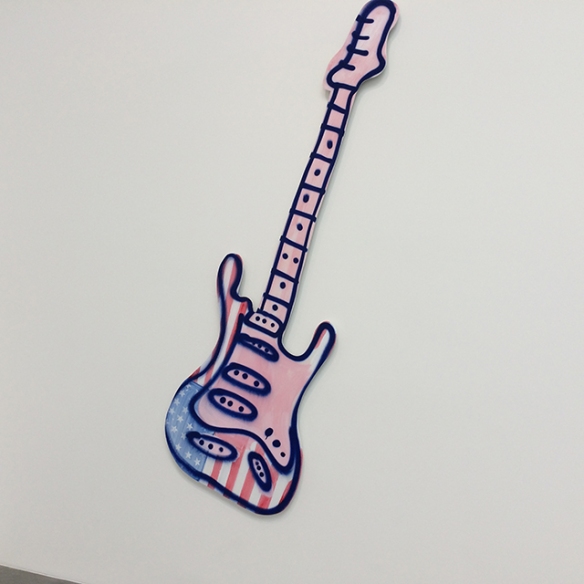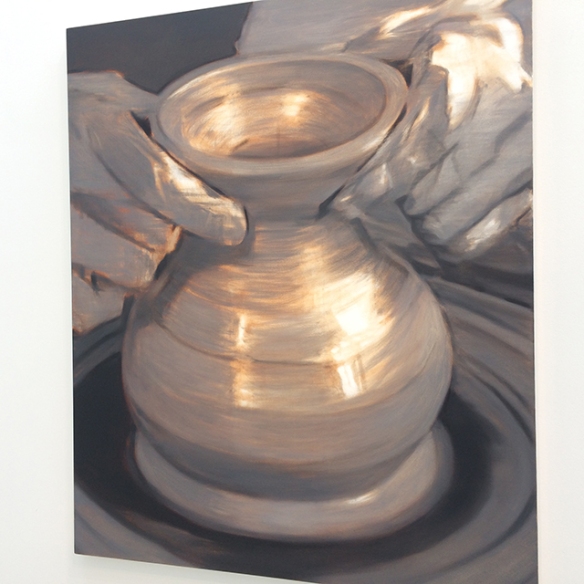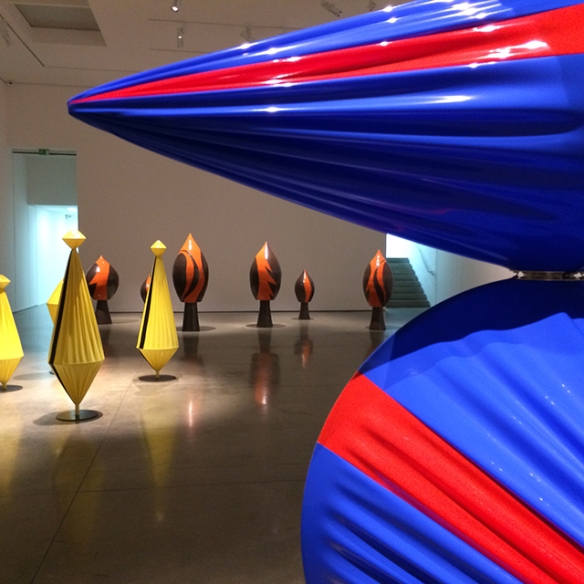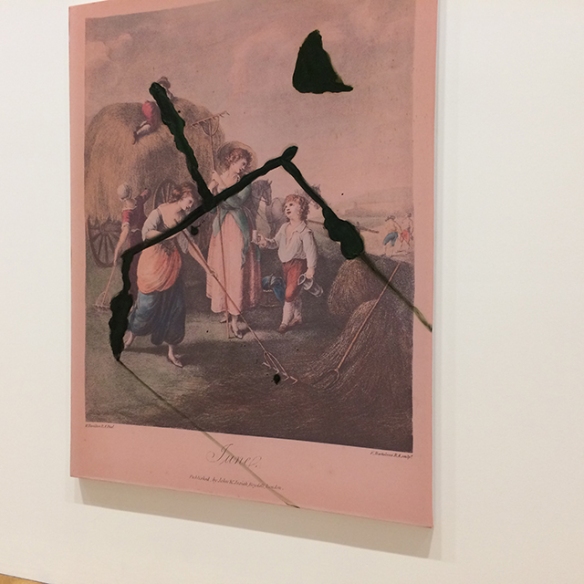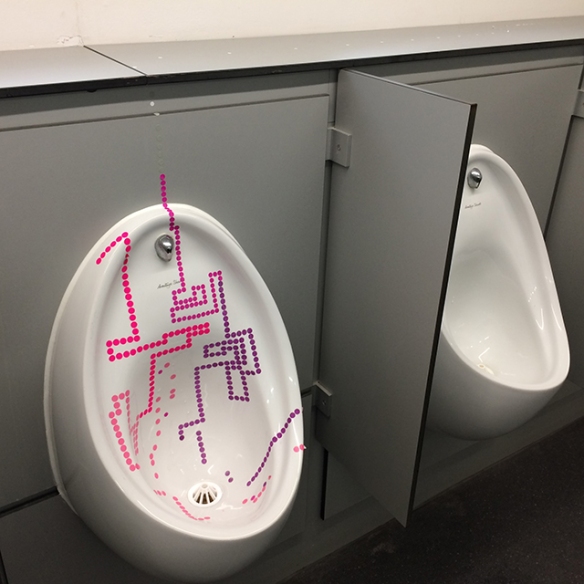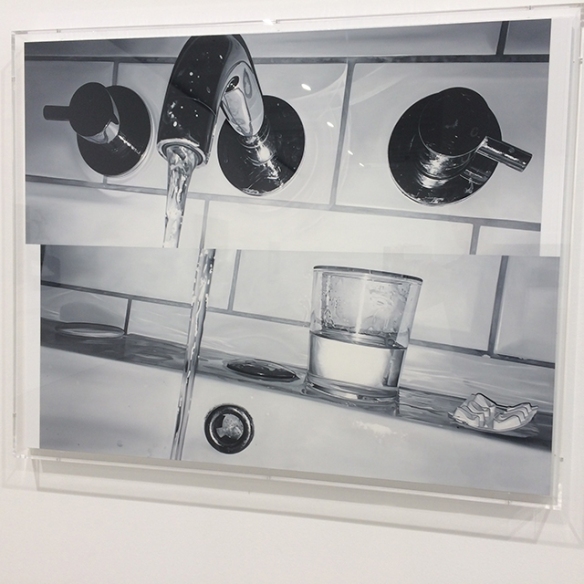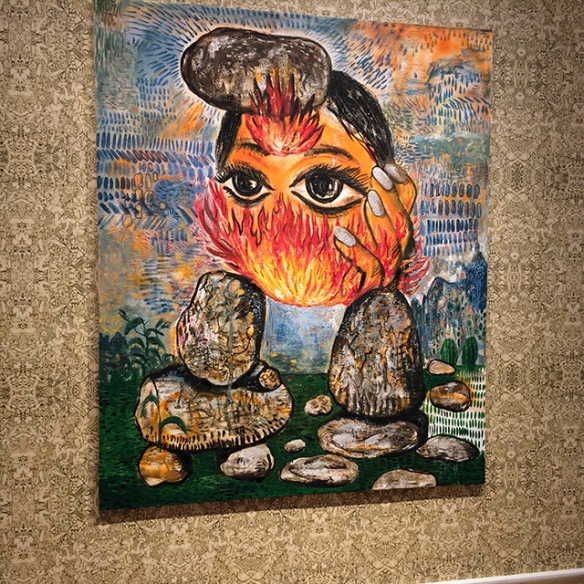The day begins with a jog up to White Cube Gallery in Mason’s Yard. Minjung Kim has used traditional Korean craft techniques to lay down layers of ultra-thin mulberry tree paper into rhythmic compositions. The paper has many uses outside of art in the artist’s native country including as window panes, due to its strength even in thin layers allowing light to diffuse between the various natural fibres. Downstairs, the artworks are vividly coloured. The paper has been dyed and applied in layers, with each piece burnt along one edge in a ritualistic gesture by the artist, one that we are told is accompanied by the smell of incense and a discipline of complete silence. The overall effect on the artworks is to create textured regions of intense colour reminiscent of flowers and natural vegetation.
In Sprueth and Magers just across Piccadilly, Anthony McCall is displaying a light installation. His use of a smoke-like mist in these light-works, allows the experience to be a 3D one rather than just the conveyance of an image from one flat medium, a digital Jpeg in a projector, to a screen on the far wall. Yes, the screen is still present as the final destination for the image, but the light wends its way through wisps of smoke, like in those cigarette-friendly cinemas of one’s youth, catching the little eddies of particles on the way, creating straight shimmering beams of light across the room. The image itself is simple enough, a single line that is curved into an ellipse, sometimes perfectly rounded, sometimes dislocated into a stepped join between end and beginning, but the transition between the two is captivating as the digital projector slowly cycles from the one to the other.
At Grosvenor Hill a few hundred metres further on, is the Gagosian Gallery. A burst of applause echoes from within the furthest room. Glenn Brown had given me a great tutorial twenty years ago and he is instantly recognisable as the same chap. With his address to a group of visitors in the background and my own sketchy knowledge of some of his main artistic concerns gleaned during that generous four hour tutorial, the work on display takes on an extra depth. The painting is ultra flat as many of us would be familiar with, whilst the waxy trails of paint from the historical canon he explores, are simulated with intricate brushwork. These labour intensive works used to net the artist just a couple of pounds an hour, a fact which he presented as a footnote to the precarious business of being an artist, during the aforementioned tutorial. It was interesting to hear from this address that whilst the paintings are still labour intensive, twenty years later, the intricate sketching style of some of the accompanying drawings is actually very quick to execute. Here, expertise of his medium appears to have allowed the artist to bend some of those time constraints of the beautiful painted works, and create an image that takes on the same rapid fluidity as those very lines he has imitated.
A second major gallery sits just round the corner and is the home of Almine Rech. Gunther Forg has several large photographs on display of variously imposing buildings. These are neo-classical in style and each is emblazoned with a title depicting the particular institution it houses. Whilst the titles such as GEOLOGIA and MUSICA are true to the original photographs, rendered in various block capitals in concrete or metal, and sitting above the grand entranceways, they nevertheless form a more extended and general index of knowledge, one which is familiar to us from library shelves and TV documentaries. Meanwhile, the buildings have a grand scale themselves, both in their photographic representation and in their actual physical size. Presented together along one wall, the images appear monumental and we get that rare sense of an illusionistic space that is actually bigger than the expansive gallery it has been presented in.

Minjung Kim at White Cube who makes images from thin layers of mulberry tree paper.

Tonico Lemos Auad of Stephen Friedman.

Bjarne Melgaard of Galerie Thaddaeus Ropac with recently finished work that fills the room with an aroma of linseed oil and paint from their drying surfaces.
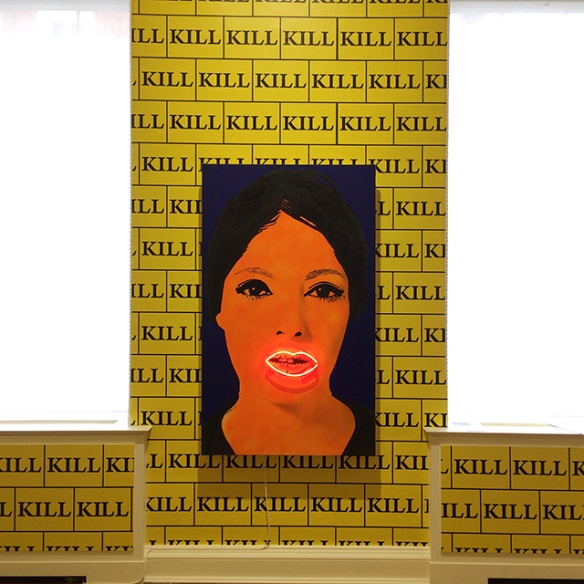
Sturtevant at Galerie Thaddaeus Ropac.

Anthony McCall at Sprueth Magers with slowly moving light projections, which uses a smoke-like substance in addition to a screen, to capture the image. The public are encouraged to move through the space and disrupt the image.

Bosco Sodi of Blain Southern with a piece at Philips.
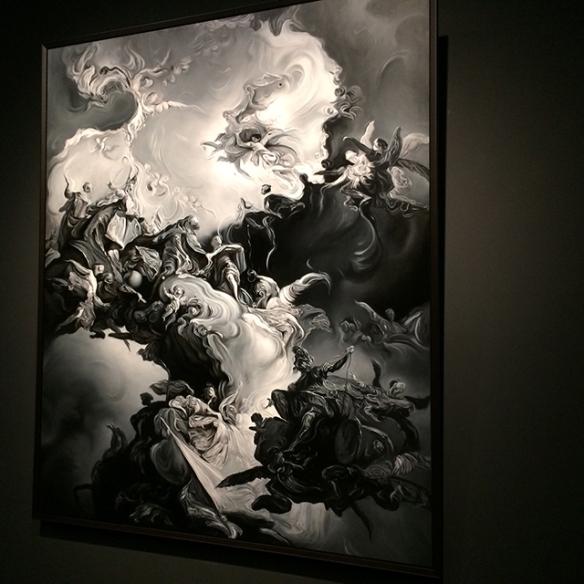
Glenn Brown of Gagosian showing paintings where the brush marks of oil paint are simulated with a flat almost photographic surface.

Gunther Forg of Almine Rech.

Sculptures on Grosvenor Hill.
 Stan Douglas at Victoria Miro Gallery. Split-screen film with two narratives.
Stan Douglas at Victoria Miro Gallery. Split-screen film with two narratives. Kings Cross cranes.
Kings Cross cranes. Li Qing at Almine Rech with double-paintings (amongst other works) which suggest “this” or “that” of various experiences.
Li Qing at Almine Rech with double-paintings (amongst other works) which suggest “this” or “that” of various experiences. Melvin Edwards at Stephen Friedman. Metal chains, locks , and here barbed wire symbolise imprisonment and containment, pertinent especially to slavery.
Melvin Edwards at Stephen Friedman. Metal chains, locks , and here barbed wire symbolise imprisonment and containment, pertinent especially to slavery. Hedda Sterne at Victoria Miro Gallery with horizontally divided paintings suggestive of seascapes with added layers to complete the composition.
Hedda Sterne at Victoria Miro Gallery with horizontally divided paintings suggestive of seascapes with added layers to complete the composition. Isa Genzken at Hauser And Wirth with an in-flight experience.
Isa Genzken at Hauser And Wirth with an in-flight experience. Alina Szapocznikow at Hauser And Wirth with resin sculptures depicting human forms and states.
Alina Szapocznikow at Hauser And Wirth with resin sculptures depicting human forms and states. An My Le at Marian Goodman Gallery with photos that evolved from Vietnamese photo- journalism, focussing on politics.
An My Le at Marian Goodman Gallery with photos that evolved from Vietnamese photo- journalism, focussing on politics. Massimo Bartolini at Frith Street Gallery with a sound organ artwork. The rotating drum yanks at pull-chords for loud blasts and catches hanging metal strips for delicate chimes.
Massimo Bartolini at Frith Street Gallery with a sound organ artwork. The rotating drum yanks at pull-chords for loud blasts and catches hanging metal strips for delicate chimes.
 The Old Kent Road tank has had a new paint job. Photographed at the beginning of today’s run. Thank you @julianlowepaintings for telling me about the new paint job.
The Old Kent Road tank has had a new paint job. Photographed at the beginning of today’s run. Thank you @julianlowepaintings for telling me about the new paint job. Egg-shaped sculpture by the River Lee. Who is the artist?
Egg-shaped sculpture by the River Lee. Who is the artist? Ed Baynard at Stephen Friedman Gallery with stylised still-lifes.
Ed Baynard at Stephen Friedman Gallery with stylised still-lifes. Jessi Reaves at Herald Street with re-purposed household items elevated to high art.
Jessi Reaves at Herald Street with re-purposed household items elevated to high art. Bruce Conner at Thomas Dane Gallery with rapidly changing images, some forming coherent sequences others seemingly random.
Bruce Conner at Thomas Dane Gallery with rapidly changing images, some forming coherent sequences others seemingly random. Ana Jotta at Greengrassi with intriguing combinations of objects that also have a theatrical feel to them.
Ana Jotta at Greengrassi with intriguing combinations of objects that also have a theatrical feel to them. Glenn Sorensen of Corvi Mora with images that seem like glimpses of nature.
Glenn Sorensen of Corvi Mora with images that seem like glimpses of nature. Chris Gilvan Cartwright at Bloomberg New Contempories.
Chris Gilvan Cartwright at Bloomberg New Contempories. Xiuching Tsay at Bloomberg New Contempories.
Xiuching Tsay at Bloomberg New Contempories. Richard Deacon at Lisson Gallery with strained, stressed and, here, undulating forms.
Richard Deacon at Lisson Gallery with strained, stressed and, here, undulating forms. Tony Cragg at Lisson Gallery with stacked forms with highly worked and intricate surfaces.
Tony Cragg at Lisson Gallery with stacked forms with highly worked and intricate surfaces.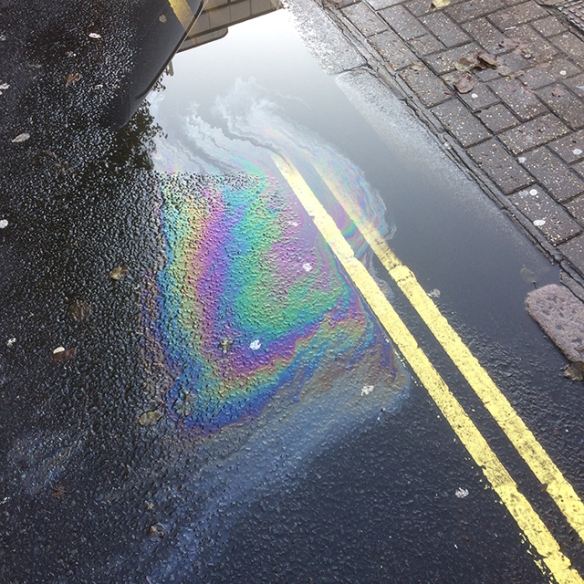 Bright oil pattern on a sunny day.
Bright oil pattern on a sunny day.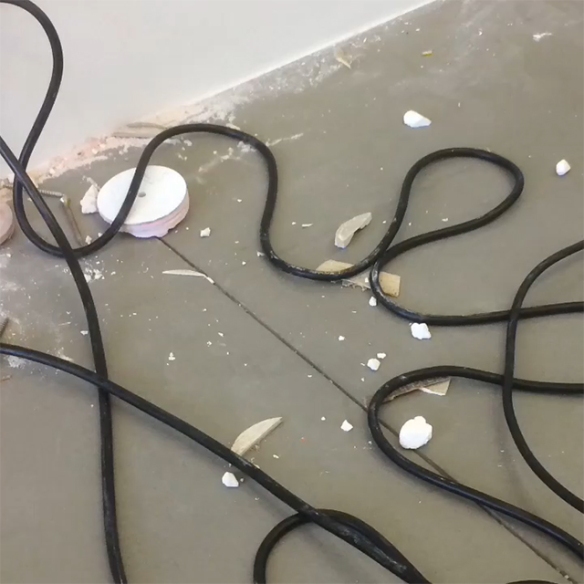 Hilary Lloyd at Sadie Coles with images and sounds from her adopted Thamesmead.
Hilary Lloyd at Sadie Coles with images and sounds from her adopted Thamesmead. Erik Lindman at Almine Rech with attractive, shard-like paintings with glimmers of light and colour set in plain backgrounds.
Erik Lindman at Almine Rech with attractive, shard-like paintings with glimmers of light and colour set in plain backgrounds.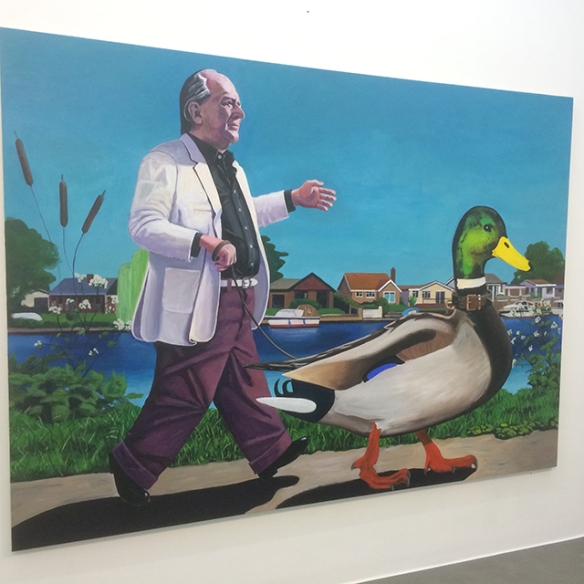 Merlin Carpenter at Simon Lee Gallery with bright well-worked paintings offering some surreal twists.
Merlin Carpenter at Simon Lee Gallery with bright well-worked paintings offering some surreal twists. Ged Quinn at Stephen Friedman Gallery with images that carry interesting surface markings that work with and against the 3d landscapes depicted.
Ged Quinn at Stephen Friedman Gallery with images that carry interesting surface markings that work with and against the 3d landscapes depicted. Mark Bradford at Hauser and Wirth with amazingly intricate paintings that have underlying stacked paper structures.
Mark Bradford at Hauser and Wirth with amazingly intricate paintings that have underlying stacked paper structures.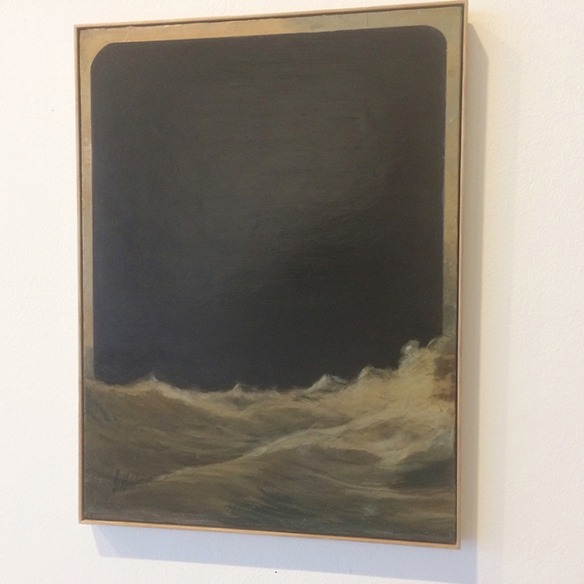 Fiona Banner at Frith Street Gallery with sea-like images and objects plus a marvellous text detachable from a giant pile at the gallery entrance.
Fiona Banner at Frith Street Gallery with sea-like images and objects plus a marvellous text detachable from a giant pile at the gallery entrance.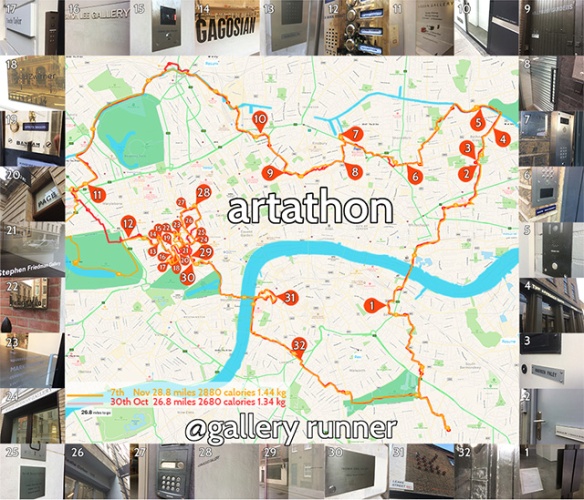 Art Marathon. Weekly runs tracked on GPS with stats, plus drop-ins at 8 galleries.
Art Marathon. Weekly runs tracked on GPS with stats, plus drop-ins at 8 galleries. Patrick Staff at Serpentine Gallery explores some of the problems humankind faces. Acid rain is simulated in the gallery with this metal drum filling up with lactic acid and acetic acid. For those into biology, these are mild organic acids important in cell metabolism.
Patrick Staff at Serpentine Gallery explores some of the problems humankind faces. Acid rain is simulated in the gallery with this metal drum filling up with lactic acid and acetic acid. For those into biology, these are mild organic acids important in cell metabolism.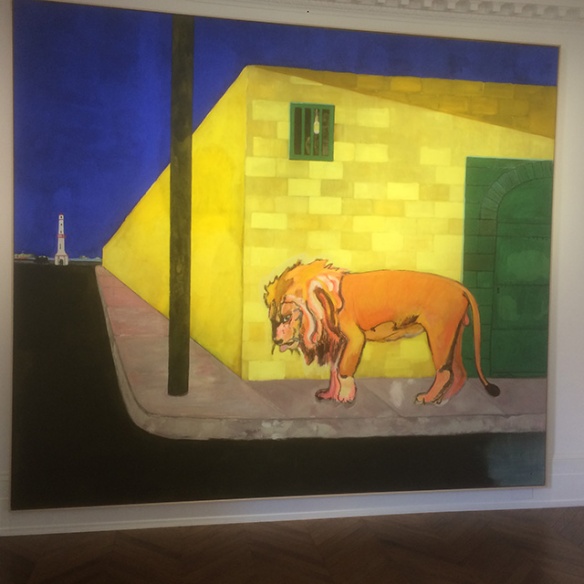 Peter Doig at Michael Werner.
Peter Doig at Michael Werner.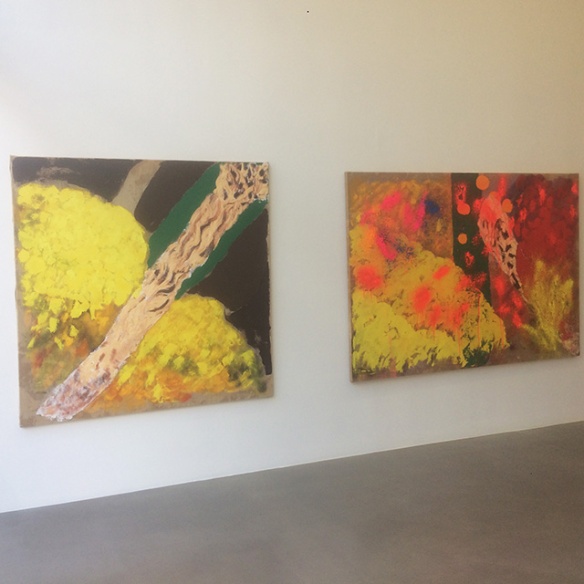 Alvaro Barrington at Sadie Coles HQ with evocative paintings.
Alvaro Barrington at Sadie Coles HQ with evocative paintings. Claire Tabouret at Almine Rech with elegant portraits.
Claire Tabouret at Almine Rech with elegant portraits.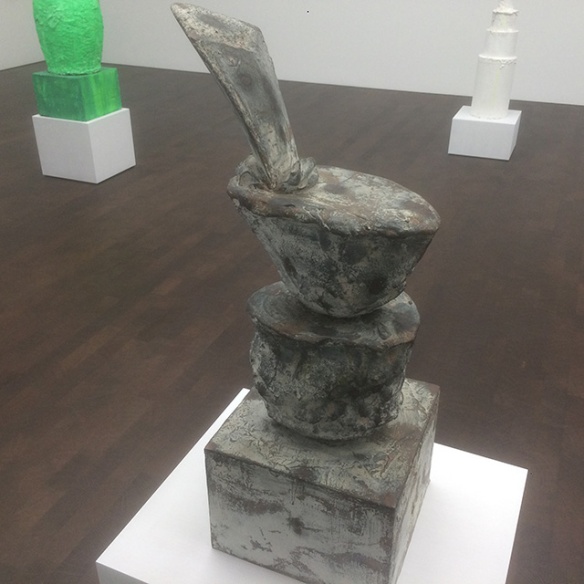 Cy Twombly at #GagosianLondon with classic style sculpture made from simple materials and some then cast in bronze.
Cy Twombly at #GagosianLondon with classic style sculpture made from simple materials and some then cast in bronze. Lisa Brice at Stephen Friedman exploring alternative representations of the female figure.
Lisa Brice at Stephen Friedman exploring alternative representations of the female figure.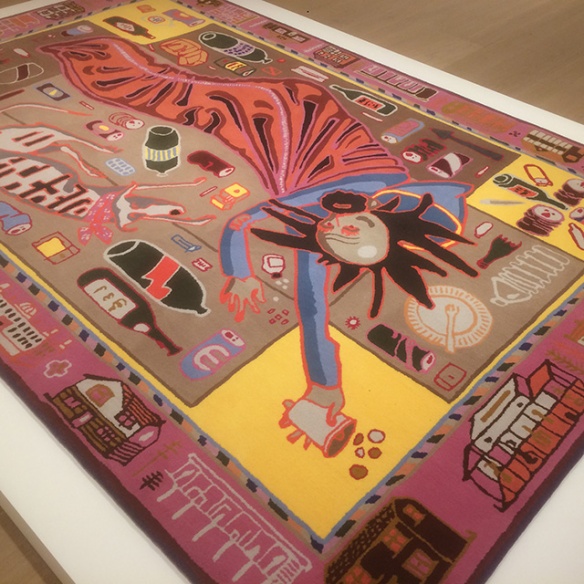 Grayson Perry at Victoria Miro Gallery with pots and woven carpets that explore social themes.
Grayson Perry at Victoria Miro Gallery with pots and woven carpets that explore social themes. Betty Parsons at Alison Jacques Gallery with beautiful painted wooden sculptures.
Betty Parsons at Alison Jacques Gallery with beautiful painted wooden sculptures. Harmony Hammond at White Cube Official with great abstract works based partly on the materiality of canvas and other fabrics.
Harmony Hammond at White Cube Official with great abstract works based partly on the materiality of canvas and other fabrics. Dora Maurer at White Cube Official with colourful shaped canvases.
Dora Maurer at White Cube Official with colourful shaped canvases. Mona Hartoum at White Cube Official . When by chance a woman was leading a tour of this show, I did a quick google search and her characteristic curly hair revealed it was in fact the artist. Fascinating tour I had tagged onto and here is something the artist described as being almost a self portrait… any guesses?
Mona Hartoum at White Cube Official . When by chance a woman was leading a tour of this show, I did a quick google search and her characteristic curly hair revealed it was in fact the artist. Fascinating tour I had tagged onto and here is something the artist described as being almost a self portrait… any guesses? Goshka Macuga at Kate Macgarry with works that on first sight seem based on the theme of weaving. However, the deeper reference is computing and the artist explains that there are many connections between the information needed to weave fabrics mechanically and that of the old computer punch cards. Surprisingly the pioneer of such technology was a not a male we have heard about, such as Charles Babbage, but rather a woman living in the early 1800’s.
Goshka Macuga at Kate Macgarry with works that on first sight seem based on the theme of weaving. However, the deeper reference is computing and the artist explains that there are many connections between the information needed to weave fabrics mechanically and that of the old computer punch cards. Surprisingly the pioneer of such technology was a not a male we have heard about, such as Charles Babbage, but rather a woman living in the early 1800’s. Cui Jie of Pilar Corrias with paintings of Chinese viewing platforms and architecture.
Cui Jie of Pilar Corrias with paintings of Chinese viewing platforms and architecture. Yoshimoto Nara and David Shrigley of #StephenFriedman with cartoon-like drawings that depict clever or witty ideas.
Yoshimoto Nara and David Shrigley of #StephenFriedman with cartoon-like drawings that depict clever or witty ideas. Jasmine Thomas Girvan at David Zwirner with intricate figurative sculptures shown alongside the paintings of Chris Ofili.
Jasmine Thomas Girvan at David Zwirner with intricate figurative sculptures shown alongside the paintings of Chris Ofili. Chris Ofili at David Zwirner with figurative paintings including this great piece.
Chris Ofili at David Zwirner with figurative paintings including this great piece. A wheel of sorts and it’s a big one.
A wheel of sorts and it’s a big one.
